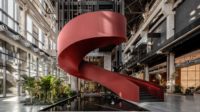Hyderabad, India
While India's Park Hotel group has forged a reputation over its 44-year history for boutique luxury establishments, its brazenly sculptural, 270-room hotel in Hyderabad is the first it has built from scratch. Priya Paul, who heads the hotel group as part of her family's conglomerate, Apeejay Surrendra, wanted to make a bold architectural statement in the center of the city on a tight site (2¼ acres) that exemplifies the dualities of India: It is across the street from a busy, noisy railroad station, but overlooks the serene Hussain Sagar Lake.
Although Hyderabad, in southern India, is known as a software development hub, Paul felt the design should express the city's centuries-old tradition of crafted jewelry associated with its pre-Independence Nizam rulers. “She considers jewelry making the essence of Hyderabad,” says Roger Duffy, of Skidmore Owings & Merrill (SOM)'s New York office, the architect for the hotel. Similarly, the client suggested to the architects that the building's opulent interiors reflect the contributions of local artisans and artists.
Paul turned to SOM to take on this assignment, notes Duffy, because she was convinced that American architects would make sure the project would be constructed with more attention to quality than has often been the case with newly built Indian hotels.
In response to zoning and height restrictions, SOM designed a trapezoidal volume, placing the six floors of guest rooms on top of a three-story podium containing shops and offices. (Parking is located in three levels below grade.) The architects then carved out the center of the trapezoid so that the third level of the podium would have an open courtyard—for a veranda and swimming pool—and be surrounded by the main lobby, lounges, and restaurants. Three sides of the trapezoidal volume wrap around the courtyard, protecting it from strong winds in the monsoon season, but allowing its veranda to benefit from lake breezes in hot weather. The infinity-edge swimming pool atop the podium takes advantage of the height: Not only are visitors shielded from the dust and noise of the railroad station, but the pool seems to stretch eternally into the lake and the city beyond.
The building's reinforced-concrete frame structure is supplemented with two long-span steel trusses to afford column-free spaces—one in the banquet hall; the other to enable a block of rooms to cantilever over the podium where it shields parts of the open areas from the sun.
To reduce solar gain and glare, and to address Paul's wishes, SOM employed a layering approach and looked at the local metalworking tradition for the design of a jewellike exterior skin of perforated and embossed aluminum. The metal-panel screen is installed in front of laminated, insulated, low-E glass windows with acoustical properties. The skin not only affords privacy for the guest rooms, but the architects shaped its openings to allow occupants to have spectacular views of the city and the lake. By night, LED panels inserted between the glass and the screens illuminate the building with vibrant hues.
The presence of the courtyard and veranda allude to India's colonial architecture; the restaurants, bars, clubs, spa, and guest rooms represent a striking mix of efforts by international design firms, including Conran & Partners, and local artisans who created such items as the glittering chandeliers and luminescent furnishings. SOM concentrated on the interior design of the street-level and main lobbies, banquet halls, shops, and the podium's lounges, veranda, and swimming pool.
The orientation of the building on its site and the design of the metal screen have reduced energy needs of the hotel by almost 30 percent, say the architects. Because of such strategies, in late 2010, the Park Hotel became India's first LEED Gold certified hotel.
To come into the hotel is to leave behind the bustle, sprawl, and dust of the city and enter a magical, beautifully crafted space. The nuanced gestures of the design connect the inside to the outside, the building to the city, and the site to the lake. The translation of the diverse challenges of energy savings, climate, privacy, and symbolic allusions to place have resulted in a singular work. The hotel's success in responding to its environmental and cultural contexts can be attested by the reaction of the client: Paul has enlisted SOM to design another Park Hotel in Calcutta.
Total construction cost: Withheld
Completion Date: April 2010
Size: 531,550 square feet
PeopleOwner: Apeejay Surrendra Park Hotels
Architect
Personnel in architect's firm who should receive special credit:
Architect of record: Interior designer: SOM executed the lobbies, public spaces, retail, veranda, and banquet halls in collaboration with local artists and craftsmen. Many other local and international interior designers were involved with the project.
Engineer(s)
Local Structural Engineer:
Local MEP Engineer:
Consultant(s)
Acoustical:
Other:
Geotechnical Engineer:
Energy Simulation:
Photographer(s) Pallon Daruwala, © Pallon Daruwala, Mobile: +91 98803 99333, pallonimages@gmail.com
CAD system, project management, or other software used: |
Products
Structural system
Exterior cladding
Metal/glass curtain wall: Global Tech Design Pte. Ltd. (Part of Permasteelisa Group - Specialist Sub- Contractor for the All Glass Connector on Level 3) Curtain wall: Permasteelisa (India), Pvt. Ltd.
Roofing
Glazing Skylights: Manufacturer of the glazing at the All Glass Connector on level 3, CSG Architectural Glass (China Southern Glass)
Insulated-panel or plastic glazing:
Local Sub-contractor/ Installer:
Doors Circular sliding doors: Ariam Door Controls - Dorma India Pvt. Ltd.
Interior finishes
Carpet: Banquet Hall: Tai Ping SOM design and custom wool carpets
Furnishings
Lighting
Add any additional building components or special equipment that made a significant contribution to this project: |













